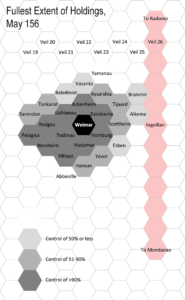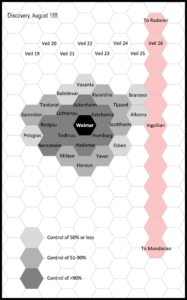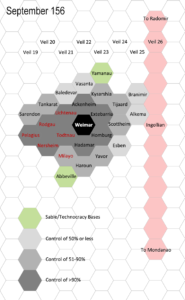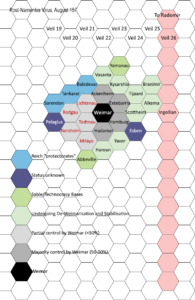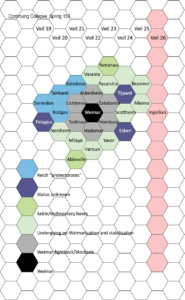Weimar Republik: External Holdings
 Weimar Bloc External Landholdings
Weimar Bloc External Landholdings
- Overview
- Key Players
- Life in the Weimar Republik
- Magic and Powers
- External Landholdings to 31 January SY158
- Current Situation
The Weimar Republik became an expansionary force shortly after the inscription of the Muster Power, which was believed to have been in around SY125. It worked on a simple three-step model.
1. A Muster initiate was sent to the target Shadow to bring up the basic tech level of that world to Weimar standard (roughly late-2010s level) unbeknownst to its inhabitants. In addition, whatever the natural day/month cycle was on those worlds, it was changed to 365/12 standard, matching Sable and the Reich. Weimar and its fully controlled worlds ran at roughly 1.2/1 relative to Sable.
2. Once the tech level was high enough for Weimar technology and weapons to work, and the inhabitants were confused from the changes in the day-night cycle, Weimar would stage a very one-sided invasion of the world (e.g. Panzer tanks against cavalry).
3. Following the invasion, the Weimar system of government would be imposed, along with implementation of technological and magical ID and security measures.
While the existence of the Weimar Bloc was unknown, this proved to be a very successful strategy. It became less so once Sable and Technocracy forces were actively trying to thwart it.
Developments from Discovery until 31 January SY 158
August 155-May 156
When the Weimar Bloc was discovered in August 155, the Republik had full control of Weimar itself, and eight other worlds (>90% control).
Weimar was protected by an impenetrable arcane/technological hybrid barrier, and secondary barriers had been erected around the six adjacent worlds). In addition, the Republik had significant control of another eight worlds (51-90% influence), and was in the earlier stages of invading another six (<50% control). Between then and May 156, the height of its expansion, it had also gained full control Pelagius and Milayo.
June-September 156
Starting in June 156, Sable and the Technocracy allied to establish a military presence in the area, both as a deterrent to further Weimar expansion, and as staging points for a future counter attack. They chose two worlds just outside the Weimar Bloc: Abbeville and Yamanau. Field Marshal Prince James was recalled from Murray to set up the Abbeville base, while General Tyla Moloney took responsibility for Yamanau.The same month, Sable forces destroyed a shapeshifter concentration camp on the partially controlled Weimar world of Yavor.
During the same period, the Reich appears to have become aware of the Weimar Republik, and Sable agents reported that they had occasionally seen their Reich counterparts in Weimar-controlled Shadows.
Between June and September, it became apparent that not all was well in certain Weimar Shadows. The first symptom of this was that the technological bootstrapping operations on those worlds where Weimar had less than 50% control ceased, and the forces were ordered to remain in their current positions and await further orders. On the worlds which Sable agents ascertained had been bootstrapped more significantly, issues were being seen with ID scanners, which allowed the allies to send scounts closer to Weimar, itself.
In tandem, starting from Lichtenau and Todtnau, which were adjacent to Weimar, Technocracy agents reported that the bootstrapped technology, in general, was less reliable than it had been previously, and posited that some kind of computer virus had been introduced into the Weimar systems. These issues began to spread to Rodgau, Nersheim and Pelagius, then ultimately to Milayo. Agents from both the Reich and Sable, as well as the Technocracy, began losing agents on the world of Pelagius, especially: they seemed to go there, operate as normal for a couple of days, and then just drop off the grid. Their fate was never confirmed.
In early-September, a strong arcane barrier was erected by the Weimar Republik, isolating those six Shadows off from the rest of the Bloc, including all technological links, thus establishing the Quarantine Zone. This barrier defeated all efforts to penetrate it, until a Black Panther squad managed to crack a hole in the border around Pelagius. As soon as they did, however, they were attacked by two or three vicious new lifeforms, which moved exceedingly fast and didn’t pull their punches. The squad finally managed to subdue one of them, to discover that they’d captured a creature that looked and acted like the Sidhe of Celtic legend. Prince Michael agreed to take charge of it for study, and to try to develop some kind of understanding with it. It was assumed that such creatures were responsible for the earlier disapperances on that world.
By the end of the month, the Weimar situation had apparently stabilised, and the Sable/Techocracy bases on Abbeville and Yamanau were fully commissioned. This allowed Sable agents to make a last attempt to get to Weimar itself, with a sample of the Namenlos virus, which had been obtained by a third-party and identified as the virus that had been causing problems in the Quarantine Zone. They succeeded on 1 October.
October 156 to August 157
The uploading of the Namenlos virus directly on Weimar started the collapse, as it caused a great deal of disruption to all the Weimar systems – not just those in the Quarantine Zone. The Republik immediately started withdrawing forces from Shadows that it had previously invaded, causing disruptions to systems and general problems as those worlds began to normalise to their pre-bootstrapped tech levels. By the following August, the former Weimar Republik Shadows were split as follows:
- The Republik retained full control of Weimar itself, minus the ID system, although it was struggling with the tech.
- It maintained majority control of four shadows: Ackenheim, Extebarria, Homburg and Hadamar. Again, the ID systems were down, but Weimar forces held the worlds, including all the major cities and towns.
- The Reich moved to “protect” the worlds of Sarendon, Tankarat and Baledevar. This did not go down well with Sable, or the Weimar authorities, who considered this an invasion.
- Sable forces moved to clean up various of the other Shadows. There were still some pockets of Weimar forces on those worlds, who were fighting a rearguard action, despite being abandoned by the Weimar authorities. Those worlds also saw a lot of both technological and climatic upheaval, as the bootstrapping process began to spiral out of control.
- One of the worlds in Sable’s sphere of influence, was Esben. As soon as they tried to move onto it, they realised that it had major problems of its own, including poisoned air and vast amounts of ash. At this point, it was quarantined by Sable forces.
- In the old Quarantine Zone, the Weimar leaders strengthened the barriers around five of the worlds. Pelagius, however, remained inaccessible to both the Allies and Weimar.
- Another world with major problems proved to be Tijaard. Originally at 1920s tech, it had been heavily bootstrapped. With the withdrawal of the Weimar forces, the sheer magnitude of the bootstrapping caused it to become highly unstable.
August 157 to end-January 158
From August 157 onwards, the disruption from the Namenlos virus continued to cause major problems for the Republik, which continued to pull in its horns. The Shadows it withdrew from continued to stabilise back from their bootstrapped tech levels, although none of them suffered as much as Tijaard.
Halbeck ventured into the former Quarantine Zone and recaptured the two border worlds that were within it, Lichtenau and Todtnau, by mid-December. Reports from the defeated Sable/Technocracy forces indicated that the Weimar troops had figured out how to gain the advantage in those theatres. Many allied forces did escape, but there were significant casualties and prisoners were taken on both sides.
An individual named Dorian Graham first came on the scene in September, working with Helmut Eckart to find solutions to Weimar’s problems. The instability on Tijaard proved an excellent testbed, as long as they stayed under the radar. By November, Sable forces had become aware of their presence, and General Moloney called in Andrew de Lacy to deal with the problem (largely, as it transpired, because Graham was a Machine Controller). This did not go entirely according to plan, resulting in a massive volcanic eruption that destroyed almost half of the Shadow, which then had to be repaired by King Robert and RFSS Delatz. It is believed that Graham was killed, but Eckart escaped, as he was seen later.
Other changes in the area included:
- In addition to the worlds of Sarendon, Tankarat and Baledevar, Rodgau came under the “protection” of the Reich.
- Sable forces continued to clean up various of the other Shadows. The rearguard actions on various worlds were defeated. Technological and climate upheaval continued to be an issue.
- A group of Sable agents did manage to access Pelagius from the Sky Shadows, but due to thin barriers between the worlds above and Pelagius at that point, a rent was torn between the two, causing significant damage to both. King Robert and the RFSS Delatz managed to heal the breach, but Pelagius became little more than a lake of Sky-Realm energy, and was locked from the outside by Sable forces, pending future investigation.
